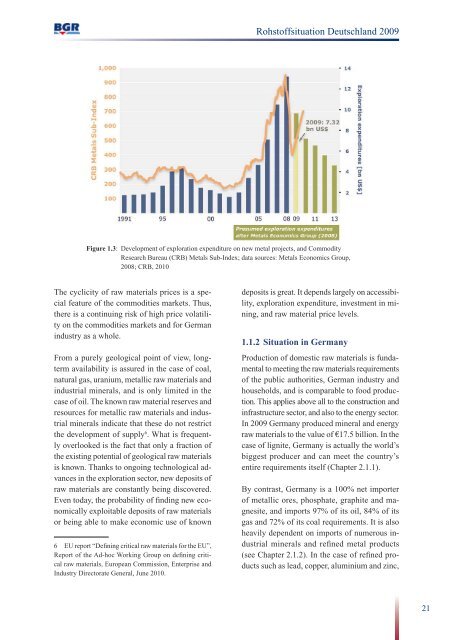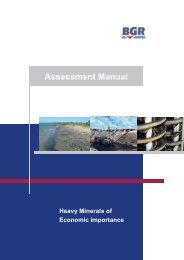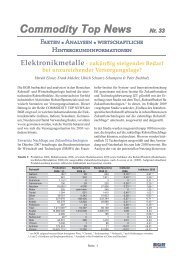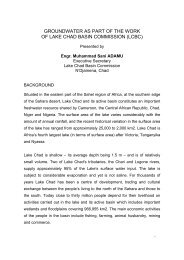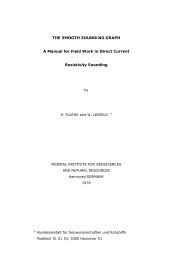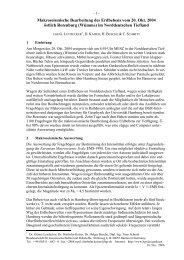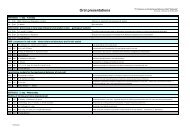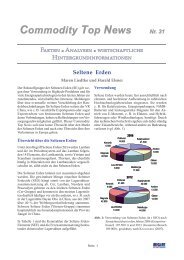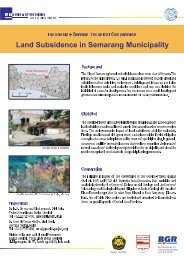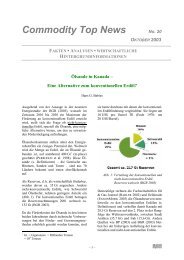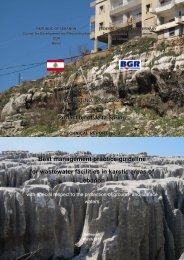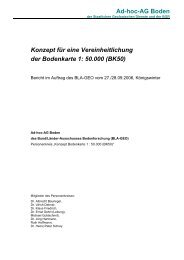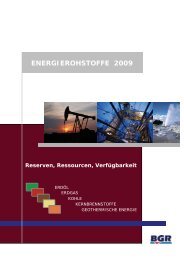Rohstoffwirtschaftliche Länderstudie - BGR
Rohstoffwirtschaftliche Länderstudie - BGR
Rohstoffwirtschaftliche Länderstudie - BGR
Sie wollen auch ein ePaper? Erhöhen Sie die Reichweite Ihrer Titel.
YUMPU macht aus Druck-PDFs automatisch weboptimierte ePaper, die Google liebt.
Rohstoffsituation Deutschland 2009<br />
Figure 1.3: Development of exploration expenditure on new metal projects, and Commodity<br />
Research Bureau (CRB) Metals Sub-Index; data sources: Metals Economics Group,<br />
2008; CRB, 2010<br />
The cyclicity of raw materials prices is a special<br />
feature of the commodities markets. Thus,<br />
there is a continuing risk of high price volatility<br />
on the commodities markets and for German<br />
industry as a whole.<br />
From a purely geological point of view, longterm<br />
availability is assured in the case of coal,<br />
natural gas, uranium, metallic raw materials and<br />
industrial minerals, and is only limited in the<br />
case of oil. The known raw material reserves and<br />
resources for metallic raw materials and industrial<br />
minerals indicate that these do not restrict<br />
the development of supply 6 . What is frequently<br />
overlooked is the fact that only a fraction of<br />
the existing potential of geological raw materials<br />
is known. Thanks to ongoing technological advances<br />
in the exploration sector, new deposits of<br />
raw materials are constantly being discovered.<br />
Even today, the probability of finding new economically<br />
exploitable deposits of raw materials<br />
or being able to make economic use of known<br />
6 EU report “Defining critical raw materials for the EU”,<br />
Report of the Ad-hoc Working Group on defining critical<br />
raw materials, European Commission, Enterprise and<br />
Industry Directorate General, June 2010.<br />
deposits is great. It depends largely on accessibility,<br />
exploration expenditure, investment in mining,<br />
and raw material price levels.<br />
1.1.2 Situation in Germany<br />
Production of domestic raw materials is fundamental<br />
to meeting the raw materials requirements<br />
of the public authorities, German industry and<br />
households, and is comparable to food produc-<br />
tion. This applies above all to the construction and<br />
infrastructure sector, and also to the energy sector.<br />
In 2009 Germany produced mineral and energy<br />
raw materials to the value of €17.5 billion. In the<br />
case of lignite, Germany is actually the world’s<br />
biggest producer and can meet the country’s<br />
entire requirements itself (Chapter 2.1.1).<br />
By contrast, Germany is a 100% net importer<br />
of metallic ores, phosphate, graphite and magnesite,<br />
and imports 97% of its oil, 84% of its<br />
gas and 72% of its coal requirements. It is also<br />
heavily dependent on imports of numerous industrial<br />
minerals and refined metal products<br />
(see Chapter 2.1.2). In the case of refined products<br />
such as lead, copper, aluminium and zinc,<br />
21


